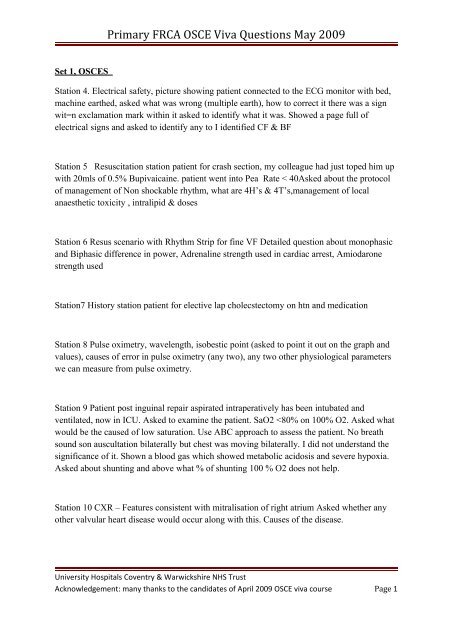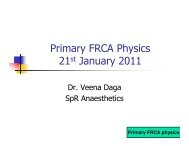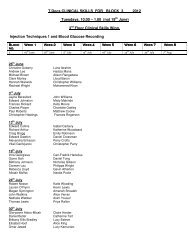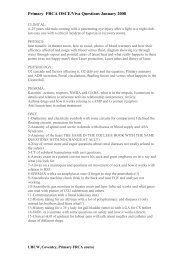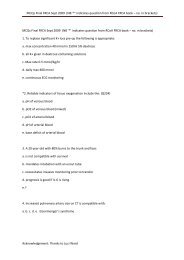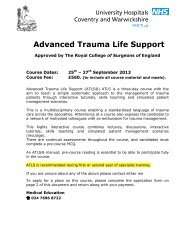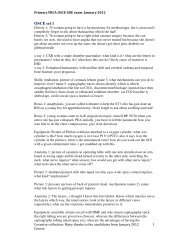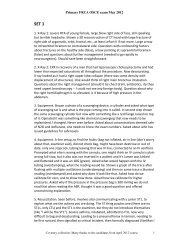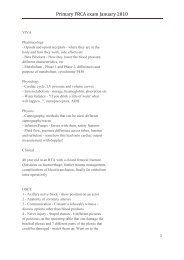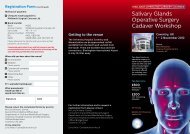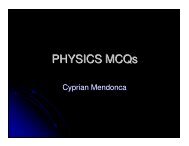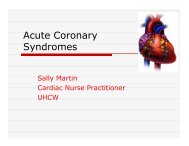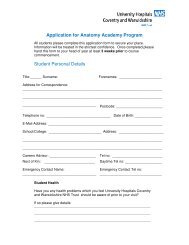Primary FRCA OSCE Viva Questions May 2009 - MEDICAL ...
Primary FRCA OSCE Viva Questions May 2009 - MEDICAL ...
Primary FRCA OSCE Viva Questions May 2009 - MEDICAL ...
You also want an ePaper? Increase the reach of your titles
YUMPU automatically turns print PDFs into web optimized ePapers that Google loves.
<strong>Primary</strong> <strong>FRCA</strong> <strong>OSCE</strong> <strong>Viva</strong> <strong>Questions</strong> <strong>May</strong> <strong>2009</strong><br />
Set 1, <strong>OSCE</strong>S<br />
Station 4. Electrical safety, picture showing patient connected to the ECG monitor with bed,<br />
machine earthed, asked what was wrong (multiple earth), how to correct it there was a sign<br />
wit=n exclamation mark within it asked to identify what it was. Showed a page full of<br />
electrical signs and asked to identify any to I identified CF & BF<br />
Station 5 Resuscitation station patient for crash section, my colleague had just toped him up<br />
with 20mls of 0.5% Bupivaicaine. patient went into Pea Rate < 40Asked about the protocol<br />
of management of Non shockable rhythm, what are 4H’s & 4T’s,management of local<br />
anaesthetic toxicity , intralipid & doses<br />
Station 6 Resus scenario with Rhythm Strip for fine VF Detailed question about monophasic<br />
and Biphasic difference in power, Adrenaline strength used in cardiac arrest, Amiodarone<br />
strength used<br />
Station7 History station patient for elective lap cholecstectomy on htn and medication<br />
Station 8 Pulse oximetry, wavelength, isobestic point (asked to point it out on the graph and<br />
values), causes of error in pulse oximetry (any two), any two other physiological parameters<br />
we can measure from pulse oximetry.<br />
Station 9 Patient post inguinal repair aspirated intraperatively has been intubated and<br />
ventilated, now in ICU. Asked to examine the patient. SaO2
<strong>Primary</strong> <strong>FRCA</strong> <strong>OSCE</strong> <strong>Viva</strong> <strong>Questions</strong> <strong>May</strong> <strong>2009</strong><br />
Station 11 Equipment station. Best position for bag masks ventilation. Required to show<br />
manoeuvres on mannequin. Showed a nasopharyngeal tube to list the complications of use of<br />
this tube.<br />
Station 12 Anatomy station. Spinal tract. Exactly same question as primary <strong>FRCA</strong> Royal<br />
college book.<br />
Station 13 History from a lady 40ish posted for hysterectomy. Had a previous history of<br />
surgery which was complicated by DVT, PE. Second surgery had discomfort because of the<br />
face mask. Smoker and profession school teacher.<br />
Station 14 Follow on station from previous history taking station. What was her<br />
haemoglobin (Did not know). What was the complication of previous surgery How was it<br />
treated How many cigarettes does she smoke per day What was her profession<br />
Station 15 Unmanned station CXR – findings hiatus hernia. Would you premedicate this<br />
patient with H2- receptor antagonists Would you insert a nasogastric tube in this patient preoperatively<br />
Is the right hemi diaphragm raised (No).<br />
Station 16 Equipment station. Airway devices. Asked to check devices on the table. ET tube<br />
(cuff was leaking); in the connector there was an obstruction. What are the equipments you<br />
would use for difficult intubations Asked questions about ambo bag.<br />
Station 17 Humidity. Asked difference between absolute and relative humidity. Picture to<br />
identify hair hygrometer, Renault’s hygrometer and Wet and dry hygrometer. Showed a<br />
graph and asked to calculate relative humidity from that. Asked about dew point.<br />
Station 18 neuromuscular monitoring station , asked about the point you would use to set up<br />
the neuromuscular monitoring asked about different modalities of monitoring , single twitch,<br />
Tetanic, post tetanic potentation asked about the position of the electrodes on the foot and<br />
what movement you would elicit( did not answer that)<br />
Station 18 base of skull , asked about cribiform fossa and 4 structures passing through it ,<br />
asked about orbital nerve block and how you would perform it asked about the complication<br />
of this block other that retrorbital haemmorage (did not Know the answer)<br />
Station19 D/w daughter about father who has been taken to theatre for leaking AAA and your<br />
registrar is in theatre<br />
University Hospitals Coventry & Warwickshire NHS Trust<br />
Acknowledgement: many thanks to the candidates of April <strong>2009</strong> <strong>OSCE</strong> viva course Page 2
<strong>Primary</strong> <strong>FRCA</strong> <strong>OSCE</strong> <strong>Viva</strong> <strong>Questions</strong> <strong>May</strong> <strong>2009</strong><br />
Station20 Cvs examination precordail examination and examination of the pulse asked about<br />
AF and the characteristic of pulse you would get.<br />
VIVA 1<br />
Physiology<br />
Define Hypoxia and the causes of Hypoxia, asked to write the formula for oxygen carrying<br />
capacity of the blood. Oxygen haemoglobin dissociation curve and name the three main<br />
points asked what will happen to the curve in hyper metabolic state ,increase in oxygen<br />
extraction and movement of the curve downward( in the beginning I went to the wrong path<br />
of leftward shift but was bought back by the examiner)<br />
Immunology what do you understand I classified them to acquired and inherited and in<br />
acquired mentioned skin, respiratory tract,GIT and tears acquired mentioned T& B<br />
lymphocytes asked about the immunoglobulin and the order in which it is inherited(i did not<br />
answer that question)<br />
Starling forced & values difference in arterial and venous forces what is the difference of<br />
values in pulmonary circulation and why is it physiologically important, to prevent<br />
pulmonary oedema<br />
Pharmacology VIVA<br />
Compare the action on the CXVS of Isoflurane, SEvoflurane and Desflurane, then asked to<br />
compare isoflurane and sevoflurane generally forget about the metabolic products then that<br />
asked about it in detail where particularly interested in compound A<br />
Pharmacokinetics Dose Response curve, Log Dose response curve with antagonist<br />
competitive and non competitive partial antagonist<br />
Digoxin Mechanism of action in dseatail digoxin toxicity and how to manage it particularly<br />
interested in haemo dialysis and at what serum concentration you would consider<br />
haemodialysis (did not know the answer)<br />
Clinical VIVA<br />
19 year old found collapsed in night club now in A/E resus<br />
ABCDE approach asked about the possible causes asked in details about the different drugs<br />
and their overdose symptoms<br />
University Hospitals Coventry & Warwickshire NHS Trust<br />
Acknowledgement: many thanks to the candidates of April <strong>2009</strong> <strong>OSCE</strong> viva course Page 3
<strong>Primary</strong> <strong>FRCA</strong> <strong>OSCE</strong> <strong>Viva</strong> <strong>Questions</strong> <strong>May</strong> <strong>2009</strong><br />
Asked about the signs of chronic alcohol abuse<br />
Drugs of abuse and their s/E<br />
Cocaine _coronary vasospasm<br />
Amphetamine -electrolyte disturbance,<br />
All of them cause electrolyte disturbance<br />
Patient intubated and ventilated in CT scan develops Cushing signs management of raised<br />
intracranial pressure, principles, carbondioxde, Blood pressure, hypoxia, pharmacological<br />
methods of management of raised ICP, mannitol asked about the dose (did not know)<br />
Physics VIVA<br />
Gas laws<br />
Asked how long can we supply a patient at 4L/min from a 5litre cylinder I said I will not be<br />
able to calculate the value without knowing the pressure in the cylinder then he gave me a<br />
value after getting the volume in the cylinder using Boyles law he did not even want me to<br />
calculate the time!!!!!<br />
Asked about Charles law, Avogadro’s hypothesis, Daltons law and grahams law<br />
ECG<br />
CM5 lead what did that mean and how would you place the electrodes, why we would use it,<br />
the degree of diminution of the value of the RMP from the heart to the ECG did not know the<br />
answer but the examiner guided with the answer asked the RMP of heart -90mv, the potential<br />
on the electrolyte1mvper 10mm so there for the diminution was approximately 90 times<br />
asked to draw the eithoven triangle and axes<br />
Resuscitation equipment and ambu bag in detail none return valve Reuben valve mushroom<br />
valve, (drew them)<br />
LMA different sizes and what weights were used<br />
Set 2<br />
SOE1 – Physiology/Pharmacology<br />
University Hospitals Coventry & Warwickshire NHS Trust<br />
Acknowledgement: many thanks to the candidates of April <strong>2009</strong> <strong>OSCE</strong> viva course Page 4
<strong>Primary</strong> <strong>FRCA</strong> <strong>OSCE</strong> <strong>Viva</strong> <strong>Questions</strong> <strong>May</strong> <strong>2009</strong><br />
pH – definition, buffers, compensatory mechanisms<br />
Pituitary gland – anatomy, hormones, ADH and osmolarity regulation in detail<br />
Ion channels – Nerst Equation, Gibbs-Donnan, Goldman Field equation<br />
Anticholinesterase - classification, side effects, organophosphate poisoning. Started with<br />
NMJ.<br />
Drug interaction in anaesthetics – general classification and then details on<br />
reversible/irreversible antagonism, dose-response curves<br />
SOE2 – Clinical and Physics<br />
‘Sux problem’ in patient requiring rapid sequence induction. General history, examination<br />
and investigations. Differential diagnosis of ‘problem’ – apnoea, anaphylaxis or MH. RSI<br />
with rocuronium was my suggestion.<br />
Flow, rotameter, Hagen-P equation, difference between laminar and turbulent<br />
Effects of altitude on PAO2 and vaporisers<br />
Pressure – units, measurements<br />
<strong>OSCE</strong><br />
Anatomy – orbit, nerves, peribulbar blocks. Facial fractures.<br />
Anatomy – spinal cord and tracts. Exactly as in college primary guide book<br />
Simulation/resus – PEA arrest in pregnant woman. I thought this was a bit haphazard as the<br />
mannequin still had a pulse even when they insisted that there wasn’t a blood pressure.<br />
Equipment – humidity and definitions. Methods of measurement. More detail about<br />
Regnaults Hygrometer and interpretation of humidity curves.<br />
Equipment/Hazards – electrical symbols (nothing simple but still in the books). Definition of<br />
earth and equipotential.<br />
Clinical skills – NMB monitoring. Where to place electrodes on wrist and lower limb. Pattern<br />
of response for TOF. Differentiation between depolarising and non-depolarising blockade.<br />
Clinical examination – CVS in particular the arterial pulses.<br />
University Hospitals Coventry & Warwickshire NHS Trust<br />
Acknowledgement: many thanks to the candidates of April <strong>2009</strong> <strong>OSCE</strong> viva course Page 5
<strong>Primary</strong> <strong>FRCA</strong> <strong>OSCE</strong> <strong>Viva</strong> <strong>Questions</strong> <strong>May</strong> <strong>2009</strong><br />
Machine – check equipment needed for RSI. Scope and ETT were faulty. Short discussion on<br />
CICV scenario.<br />
History – patient about to undergo AV fistula formation. Previous awareness under<br />
anaesthesia.<br />
Communication – AAA rupture as per course.<br />
History/Communication – 2 part station. TAH in patient with heavy periods. Hb check.<br />
Previous problems with GA – awareness during emergency C. Section and traumatic<br />
experience as child from face mask.<br />
Radiology – I think it was coarctation of aorta. The questions were leading that way but<br />
unconvinced by actual x-ray.<br />
Radiology – Large hiatus hernia.<br />
Simulation/Resus – ITU patient, intubated and ventilated as aspirated during induction. Low<br />
sats. Tube too far in and developing ARDS. PEEP suggested.<br />
Resus – talk with examiner about the management of VF. Very straight forward.<br />
Clinical skills – maintainging airway. Head position in adult and paeds. Nasopharyngeal<br />
airway.<br />
Set 3<br />
Pharmacology / physiology<br />
draw the arterial wave from, explain how if differs from<br />
aorta to radial artery<br />
draw a pressure volume loop and explain how it changes<br />
with increased contractility<br />
explain the ventilatory response to hypercapnia when<br />
rebreathing<br />
explain the ventilatory response to hypoxia<br />
tell me some of the functions of the liver<br />
explain liver blood flow<br />
draw the structure of the liver lobule and explain it<br />
tell me about commonly used iv induction agents<br />
tell me about thiopentone, can you draw it, what are<br />
structure activity relationships,<br />
tell me about ketamine<br />
tell me about classes of drugs used in asthma<br />
what variants are there in metabolism of anaesthetic drugs<br />
- sux apnea and porphyria<br />
University Hospitals Coventry & Warwickshire NHS Trust<br />
Acknowledgement: many thanks to the candidates of April <strong>2009</strong> <strong>OSCE</strong> viva course Page 6
<strong>Primary</strong> <strong>FRCA</strong> <strong>OSCE</strong> <strong>Viva</strong> <strong>Questions</strong> <strong>May</strong> <strong>2009</strong><br />
clinical - a 65 year old man needs a laparotomy for a<br />
perforated viscus, INR is 5 because of warfarin for DVT,<br />
biochemically dehydrated<br />
what are your concerns<br />
what are you going to do<br />
discuss how to correct his coag<br />
how will you anaesthetise him<br />
critical incident - HR goes up tp 145, hypotensive -<br />
causes, how do you treat it<br />
physics<br />
identify these electrical symbols - electrical components<br />
what factors influence electrical resistanve<br />
what is ohms law, what is power<br />
severinghaus electrode, calibration graph<br />
features and faults of a syringe driver pump<br />
<strong>OSCE</strong><br />
16 - XR of aortic coarctation<br />
15- check equipment for RSI and failed intubation routine<br />
14- questions on humidity<br />
13 - qs on nerve stimulator and patterns of block<br />
12 - qs on skull anatomy, eye block<br />
11- qs on electrical safety and symbols<br />
10- communication - aortic aneurysm relative<br />
9 - resus - pregnant woman, LA toxicity<br />
8- resus - ALS algorithm<br />
7 - history - previous awareness (CRF, new AV fistula)<br />
6 - critical incident SIM man - endobronchial intubation<br />
5 - paediatric resuscitation - differences between paeds<br />
airway and adult<br />
4 - XR - lateral chest with hiatus hernia<br />
3- hx - take hx from female for hysterectomy<br />
2- present hx / questions on hx gained<br />
1 - spinal cord anaomy and tracts<br />
Set 4<br />
<strong>Primary</strong> <strong>FRCA</strong> <strong>Questions</strong> MAY <strong>2009</strong><br />
Physiology viva:<br />
University Hospitals Coventry & Warwickshire NHS Trust<br />
Acknowledgement: many thanks to the candidates of April <strong>2009</strong> <strong>OSCE</strong> viva course Page 7
<strong>Primary</strong> <strong>FRCA</strong> <strong>OSCE</strong> <strong>Viva</strong> <strong>Questions</strong> <strong>May</strong> <strong>2009</strong><br />
1) Frank –starlings law; cardiac cycle; pressure volume loops- with afterload and<br />
preload, along with definitions.<br />
2) Alveolar gas equation and its significance.<br />
3) Hormones and HPA, negative feedback mechanism<br />
Pharmacology <strong>Viva</strong>;<br />
1) Receptors and ligands, Types of receptors, steroids.<br />
2) NDMR, MOA and metabolism, Hoffmans and ester hydrolysis.<br />
3) Steroids and administration during surgery.<br />
Physics:<br />
1) Calibration ( 2 point, 3point) where used in practice.<br />
2) Magnets- where used in practice( spoke about paramagnetic analysers and MRI)<br />
Asked in details about MRI.<br />
3) Ventilators and its classification<br />
Clinical:<br />
75 yr old obese lady, on the list for strangulated umbilical hernia, is also a heavy smoker and<br />
type 2 diabetic on metformin. Discuss in regard to obesity.<br />
<strong>OSCE</strong>:<br />
1) Simman : tracheostomy out reinsertion not possible—went through DAS Guidelines<br />
2) History on an asian female with thalassemia.<br />
3) Vertebrae: axis –where does the vertebral artery lie.Denticulate ligament. Odontoid<br />
peg to be identified.Borders of the epidural space, where spinal cord ends in adults<br />
and kids.<br />
4) Art line set up with flaws to be identified.<br />
5) Bains Breathing system chaeck<br />
6) Intraosseus insertion.<br />
7) Cardiac angiography identify LCA- Circumflex and LAD.<br />
8) Counselling mum as child with sux apnea.<br />
9) Bradyarrthymias to be managed.<br />
10) Tachyarrthymias management with defib use<br />
11) Identify clarkes electrode and its parts.<br />
12) Xray :seemed to be ARDS, so managed it as such<br />
13) Pulmonary angiogram of a pt with burns- showed a pneumothorax<br />
14) History taking of a pt for laprotomy and the next station was for the questions<br />
University Hospitals Coventry & Warwickshire NHS Trust<br />
Acknowledgement: many thanks to the candidates of April <strong>2009</strong> <strong>OSCE</strong> viva course Page 8
<strong>Primary</strong> <strong>FRCA</strong> <strong>OSCE</strong> <strong>Viva</strong> <strong>Questions</strong> <strong>May</strong> <strong>2009</strong><br />
15) Laser tube with questions on safety with lasers<br />
16) Explain the suitability of a pt. for GA or SA who has preeclampsia.<br />
17) Axillary approach of brachial blockade<br />
Set 5<br />
<strong>OSCE</strong><br />
- Communication: talk to a daughter of a man admitted for urgent AAA repair<br />
- History taking: Woman in her 5os for AV-fistula<br />
- History taking, two-step station: woman in her 40s for abdo hysterectomy<br />
- Resusc: PEA in preganant woman after a 20 ml 0.5% bupi epidural top up<br />
- Resusc: Collapse on the ward: VF<br />
- SIMMAN: low SpO2: recognise R endotracheal intubation<br />
- Physical examination: Pulse and heart examination<br />
- Equipment: check RSI equipment: various faults: leaking tube cuff, broken McGill, pieces<br />
of plastic in the connection. Add which other equipment will be needed: drugs, IV, fluids,<br />
suction, GEB, tipping trolley.<br />
- Skills: demonstrate bag-mask ventilation on a manikin and various questions about ambu<br />
bags, cricoid pressure, etc<br />
- Standard questions about pulsoxymeter<br />
- Neurostimulator: recognise various patterns, quastions about voltages, location of the<br />
electrodes on the wrist and ankle<br />
- Station on electrical safety and symbols<br />
- Anatomy: orbit with structures passing through optic canal, superior issure, lamina cribrosa,<br />
etc.<br />
- Anatomy: spinal cord: very similar to the one in the college book.<br />
- Chest X-ray: coarctation of the aorta<br />
- Chest X-Ray: hiaus hernia (Left lateral view)<br />
can't remember the last 4...<br />
VIVAs<br />
Physiology<br />
- Definition and classification of hypoxia, HB sissociation curve, CaO2, etc<br />
- Capillary bed hydrostatic/oncotic pressures in the systemic cirulation differences in the<br />
renal and pulmonary bed circulation<br />
- Immune system: classification, role of te different white cells, hypersensitivity reactions<br />
type I-V<br />
Pharmacology:<br />
University Hospitals Coventry & Warwickshire NHS Trust<br />
Acknowledgement: many thanks to the candidates of April <strong>2009</strong> <strong>OSCE</strong> viva course Page 9
<strong>Primary</strong> <strong>FRCA</strong> <strong>OSCE</strong> <strong>Viva</strong> <strong>Questions</strong> <strong>May</strong> <strong>2009</strong><br />
- compare Sevo and Des<br />
- agonist antagonist curves<br />
- all about Digoxine<br />
Physics<br />
- Gas laws and their application to anaesthetics<br />
- ECG<br />
- Bag-valve mask: components, materials, differences btw paediatric and adult models.<br />
Clinical:<br />
- 19y old man fallen down the stairs in a night club at 2 am, brought to AE, discussion about<br />
intracranial haemorrage, raised ICP, monitoring and transfer, mannitol, RSI...<br />
Set 6<br />
<strong>OSCE</strong><br />
1.Called to ITU @ 2:00 am doe desaturating 70 yr old gentleman; Tracheostomy tube<br />
out( inserted only 48 hrs ago) known difficult intubation.<br />
2.X-ray – pulmonary oedema<br />
3.Axillary block on actor n follow on questions<br />
4.History station<br />
5. Follow on questions<br />
6.CT chest on inhalational injury.<br />
7.Bains circiut check<br />
8. O2 electrodes – pictures n questions<br />
9.Intra ossious needle insertion<br />
10. Sux apnoea – communication to mother( mum was really bored n kept looking out of the<br />
window!!)<br />
11.ALS scenario – shockable ECG<br />
12.ECG rhytmn strip – SVT n questions<br />
13. Arterial line set up n faults<br />
14.History station<br />
University Hospitals Coventry & Warwickshire NHS Trust<br />
Acknowledgement: many thanks to the candidates of April <strong>2009</strong> <strong>OSCE</strong> viva course Page 10
<strong>Primary</strong> <strong>FRCA</strong> <strong>OSCE</strong> <strong>Viva</strong> <strong>Questions</strong> <strong>May</strong> <strong>2009</strong><br />
15.Anatomy station –Vertebras 100 s of them – C1 n C2 as well(had not seen them since<br />
MBBS days)<br />
16.Anatomy of heart- Angiogram n questions<br />
17. Examine a pregnant lady for GA/ regional. You can ask for any results and equipment u<br />
to aid ur examination.<br />
VIVA – PHYSIO- PHARMAC<br />
PHYSIO-<br />
1. Adrenoreceptors. Differences b/n Adrenaline n Noradrenaline<br />
2. Structure of sarcomere both relaxed n contracted with all the lines. Excitationcontraction<br />
coupling<br />
3. Starvation n all the cycles(krebs)<br />
1. Diuretics<br />
2. Local anaesthetics<br />
3. Dose-response n log dose response curves<br />
1. Pressure n invasive arterial setup n principles<br />
2. Pulse oximetry n graphs( wanted graph of absorbance against time)<br />
3. Ventilators n graphs of flow/time n pressure/time<br />
PHARMAC-<br />
PHYSICS-<br />
CLINICAL-<br />
45 yr old for elective Abdominal hysterectomy with 2 finger mouth opening. Outline<br />
anaesthetic management.<br />
Set 7<br />
SOE1<br />
Physiology:<br />
arterial pressure trace, what can you tell from it Draw<br />
the pressure volume loop for the LV, what happens in<br />
failure<br />
The liver blood supply and metabolism<br />
University Hospitals Coventry & Warwickshire NHS Trust<br />
Acknowledgement: many thanks to the candidates of April <strong>2009</strong> <strong>OSCE</strong> viva course Page 11
<strong>Primary</strong> <strong>FRCA</strong> <strong>OSCE</strong> <strong>Viva</strong> <strong>Questions</strong> <strong>May</strong> <strong>2009</strong><br />
What happens to minute volume when rebreathing CO2, draw a<br />
graph with MV and time. What effects would this have on<br />
the patient<br />
Pharmacology:<br />
IV induction agents. Draw thio or propofol and discuss<br />
differences generally<br />
How do different people handle drugs differently<br />
Drugs used in asthma - how do they work<br />
SOE 2<br />
Clinical:<br />
62 year old man, emergency laparotomy for perforated<br />
viscus, on warfarin for previous PE 6 months ago, INR 5.8<br />
mild ARF<br />
Management, fluid managment, management of INR and<br />
subsequent anticoagulation<br />
Patient becomes tachycardic and hypotensive on table<br />
Physics<br />
Identify electrical symbols. When do we use resistors<br />
Principles around resistors, pressure transducers.<br />
Electrical safety, how do we get electricity<br />
Capacitors, when do we use them, defibrillator.<br />
pumps, drip counters, problems and safety around pumps<br />
(awful)<br />
<strong>OSCE</strong><br />
Examine the arterial pulse and the praecordium<br />
Base of skull, orbit and peribulbar blocks<br />
Diagram regarding electrical safety, identify symbols, say<br />
why patient doesn't get electrocuted by ECG<br />
principles behind pulse ox - the question straight from<br />
the college book<br />
Take a history from a woman having an AV fistula formed<br />
with previous history of awareness<br />
Resus 1: pregnant lady in PEA, probably IV LA injected<br />
Resus 2: discuss ALS guidelines, questions on algorithm<br />
Check equipment needed for RSI. Holes in cuff, no bougie,<br />
magills didn't open<br />
Sim man - tube in right main bronchus, questions on shunt<br />
Cross section of spinal cord, questions straight out of<br />
college book<br />
University Hospitals Coventry & Warwickshire NHS Trust<br />
Acknowledgement: many thanks to the candidates of April <strong>2009</strong> <strong>OSCE</strong> viva course Page 12
<strong>Primary</strong> <strong>FRCA</strong> <strong>OSCE</strong> <strong>Viva</strong> <strong>Questions</strong> <strong>May</strong> <strong>2009</strong><br />
Humidity, questions on hygrometers<br />
History from woman for TAH with awareness - straight from<br />
college book too<br />
X ray 1: probably co arctation of aorta<br />
X ray 2: lateral chest showing hiatus hernia and further<br />
questions on this<br />
Airway adjuncts, NPA, emergency airways<br />
Communication: daughter of 82 year old man having<br />
emergency AAA repair<br />
Set 8<br />
Physiology viva<br />
1 Write down the normal values for CVP, HR, BP, CO. What happens to these<br />
values if 20% haemorrhage occurs What are the physiological responses to 20%<br />
blood loss if left untreated What neural and hormonal responses occur Tell me<br />
more detail about the hormonal responses that occur<br />
2 Write a table comparing the concentrations of various intracellular and<br />
extracellular ions. What are the functions of magnesium What are the functions<br />
of phosphate<br />
3 What is compliance Draw a diagram representing lung compliance (pressurevolume<br />
curve of lung). What are static and dynamic compliance, why do they<br />
differ What are the components of total compliance of the respiratory system<br />
Name some causes of altered compliance of the lung. What happens to<br />
compliance in paediatric respiratory distress syndrome! What is surfactant What<br />
is Laplace’s law<br />
Phamacology viva<br />
1 What are the factors affecting uptake of inhaled agents Draw a graph showing<br />
how low and high minute ventilation affect uptake. What is the blood-gas<br />
solubility coefficient<br />
2 Define volume of distribution. Why factors influence the differences in Vd of a<br />
drug. Give a couple of examples of drugs with high Vd and low Vd. Define<br />
clearance. How are Vd and clearance related<br />
3 What are the mechanisms by which drugs affect gastric pH Name some examples<br />
of each type of drug. Draw a gastric parietal cell and show the receptors these<br />
drugs act on. What exactly happens at the receptors (H+ proton pump and<br />
histamine H2 receptor)<br />
University Hospitals Coventry & Warwickshire NHS Trust<br />
Acknowledgement: many thanks to the candidates of April <strong>2009</strong> <strong>OSCE</strong> viva course Page 13
<strong>Primary</strong> <strong>FRCA</strong> <strong>OSCE</strong> <strong>Viva</strong> <strong>Questions</strong> <strong>May</strong> <strong>2009</strong><br />
Clinical scenario<br />
30 year old primip with epidural in situ for labour pain relief is handed over to you. You are<br />
informed that she is failing to progress and will need C-section.<br />
1 How would you assess this woman for C-section. What would you check with the<br />
obs registrar What different categories of urgency are there for C-section. What<br />
category does this fall into How would you top up her epidural for LSCS<br />
2 During the section, after baby has been delivered, she starts to complain of severe<br />
abdominal pain. How would you manage this She declines GA, what would you<br />
do<br />
3 You go and see this lady 24 hours later. What would you tell her Specifically,<br />
what would you say regarding pain relief for future pregnancies What<br />
complications from her epidural would you be looking out for at this stage. What<br />
might be the causes of residual weakness How would you assess her What else<br />
might she complain of What is the cause of post-dural puncture headache How<br />
would you manage PDPH<br />
Everyone came out of this asking what the critical incident had been. It wasn’t your standard,<br />
‘ABC, 100% O2, I would call for help, alert my consultant etc’. It was much more like a<br />
discussion regarding what the options are for managing pain during LSCS if GA is refused.<br />
Discusion was regarding opiates (IV and epidural), use of local anaesthetics, what might the<br />
surgeons be doing, would you use midazolam.<br />
Physics viva<br />
1 What are the causes of heat loss from a patient in theatre, and in what proportion<br />
do these occur What is radiant heat loss What form of energy is this What is<br />
convective heat loss Why does this occur and how can it be minimised What is<br />
evaporative heat loss Where does this occur from What is the latent heat of<br />
vaporisation Why does it cause heat loss What is conductive heat loss Why is<br />
so much heat lost from the head and face What methods are there to limit heat<br />
loss during surgery<br />
2 With regard to blood pressure monitoring, what do you understand by static<br />
response and dynamic response (I asked around about this later – no candidate I<br />
spoke to felt they knew the answer to it, most mentioned static and dynamic<br />
measurement of lung compliance.) The examiner then drew axis for a pressure<br />
time curve and drew a rectangle (as if a flush was going through an art line): What<br />
is the pressure of the pressurised bag in a art line system What happens after the<br />
flush is released I then went on to draw the response seen under different<br />
damping conditions. What is Fourier analysis What is the fundamental<br />
University Hospitals Coventry & Warwickshire NHS Trust<br />
Acknowledgement: many thanks to the candidates of April <strong>2009</strong> <strong>OSCE</strong> viva course Page 14
<strong>Primary</strong> <strong>FRCA</strong> <strong>OSCE</strong> <strong>Viva</strong> <strong>Questions</strong> <strong>May</strong> <strong>2009</strong><br />
Set 9<br />
frequency What are harmonics How many harmonics are necessary to formulate<br />
most biological signals<br />
3 Picture shown of 3 different ET tubes. What are all of these (normal Cuffed ETT,<br />
South-facing RAE tube and uncuffed paediatric tube). Take me through all the<br />
markings on the normal ETT. What length would you ask your ODP to cut the<br />
tube to What does RAE stand for What is this (Murphy eye). What is it for<br />
What is different about the paediatric tube Why no cuff What age child is this<br />
tube for (it was a size 4 tube) What else is unusual about the tube (8mm<br />
connectors)<br />
SCE<br />
- Communication: talk to a daughter of a man admitted for urgent AAA repair<br />
- History taking: Woman in her 5os for AV-fistula<br />
- History taking, two-step station: woman in her 40s for abdo hysterectomy<br />
- Resusc: PEA in preganant woman after a 20 ml 0.5% bupi epidural top up<br />
- Resusc: Collapse on the ward: VF<br />
- SIMMAN: low SpO2: recognise R endotracheal intubation<br />
- Physical examination: Pulse and heart examination<br />
- Equipment: check RSI equipment: various faults: leaking tube cuff, broken McGill, pieces<br />
of plastic in the connection. Add which other equipment will be needed: drugs, IV, fluids,<br />
suction, GEB, tipping trolley.<br />
- Skills: demonstrate bag-mask ventilation on a manikin and various questions about ambu<br />
bags, cricoid pressure, etc<br />
- Standard questions about pulsoxymeter<br />
- Neurostimulator: recognise various patterns, quastions about voltages, location of the<br />
electrodes on the wrist and ankle<br />
- Station on electrical safety and symbols<br />
- Anatomy: orbit with structures passing through optic canal, superior issure, lamina cribrosa,<br />
etc.<br />
- Anatomy: spinal cord: very similar to the one in the college book.<br />
- Chest X-ray: coarctation of the aorta<br />
- Chest X-Ray: hiaus hernia (Left lateral view)<br />
can't remember the last 4...<br />
VIVAs<br />
Physiology<br />
- Definition and classification of hypoxia, HB sissociation curve, CaO2, etc<br />
University Hospitals Coventry & Warwickshire NHS Trust<br />
Acknowledgement: many thanks to the candidates of April <strong>2009</strong> <strong>OSCE</strong> viva course Page 15
<strong>Primary</strong> <strong>FRCA</strong> <strong>OSCE</strong> <strong>Viva</strong> <strong>Questions</strong> <strong>May</strong> <strong>2009</strong><br />
- Capillary bed hydrostatic/oncotic pressures in the systemic cirulation differences in the<br />
renal and pulmonary bed circulation<br />
- Immune system: classification, role of te different white cells, hypersensitivity reactions<br />
type I-V<br />
Pharmacology:<br />
- compare Sevo and Des<br />
- agonist antagonist curves<br />
- all about Digoxine<br />
Physics<br />
- Gas laws and their application to anaesthetics<br />
- ECG<br />
- Bag-valve mask: components, materials, differences btw paediatric and adult models.<br />
Clinical:<br />
- 19y old man fallen down the stairs in a night club at 2 am, brought to AE, discussion about<br />
intracranial haemorrage, raised ICP, monitoring and transfer, mannitol, RSI...<br />
Set 9<br />
SOE<br />
Pharmacology:<br />
-Define MAC. Types of MAC. Factors governing MAC.<br />
-Define Bioavailiblity. How do you measure it. Factors goverrening it.<br />
-What types of classification of anti-arrythmics are you aware of Draw a Cardiac action<br />
potential and show action of each of the clases of Vaughn Williams classification.<br />
-Discuss Indications, MOA, & S/E of Amiodarone<br />
Physiology:<br />
-Draw pressure changes in the Right ventricle durinng crdiac cycle.<br />
-Superimpose Pressure changes in Left ventrile on an arterial trace.<br />
-Show how an ECG relates to the graph showing the Pressure changes in Left ventrile during<br />
the cardiac cycle.<br />
-How is CO2 carried in the body Show how Co2 in transported at tissue level and at lungs.<br />
What is the Bohr effect What is the Haldane effect<br />
-Draw CO2 dissociation curve. Show the Haldane effect.<br />
Physics:<br />
-What types of Laryngoscopy blades are you aware of Indictions for each type.<br />
-How do you assess flow in Gases and Fluids Ficks principle.<br />
University Hospitals Coventry & Warwickshire NHS Trust<br />
Acknowledgement: many thanks to the candidates of April <strong>2009</strong> <strong>OSCE</strong> viva course Page 16
<strong>Primary</strong> <strong>FRCA</strong> <strong>OSCE</strong> <strong>Viva</strong> <strong>Questions</strong> <strong>May</strong> <strong>2009</strong><br />
-What does Laser stand for How is it produced Types of Lasers ad their indications.<br />
Precautions during laser surgery.<br />
Clinical:<br />
6yr boy for an Elective Tonsillectomy for recurrent snorring at night. PMHx-Asthma on<br />
regular inhalers. Recent cold 6 days ago.<br />
-How would you assses. Points of concern.<br />
-ow would you asses the severity of OSA & asthma. Implitions of the same on your<br />
anaesthetic.<br />
-What are the indications for intubtion What type of tube, ventiltor support <br />
-Pain relief. Concerns for opiate use for the samme<br />
-Critical incident:Post-op hypoxia.<br />
-Mgm of bleeding post-op tonsillectomy.<br />
<strong>OSCE</strong>:<br />
1> Nerve stimulator: Where would you place the electrodes. Desribe features on graphs of -<br />
Single stimilus, TOF, Post-tetanic stimulation.<br />
2> Anatomy: Cribriform plate. Le forts fracture classification. Orbit and eye blocks. Superior<br />
orbital fissure and optic canal contents. Describe peri-bulbar block and its complications.<br />
3> History taking of a lady due for laproscopic cholecystectomy. Asthmatic.<br />
4> Cardiac arrest in labour post Bupivacaine epidural top-up.<br />
5> Examine Radial artery and auscultate precordium.<br />
6> ECG: VF. Treatment options.<br />
7> Electrical safety. Equipotential. Classification of instuments based on their design and<br />
maximum leakage current.<br />
8> Communication: Speak to daughter of a 82yr. old patient brought in with a ruptutred<br />
Abdominal Aortic Aneurysm.<br />
9> Simulation: Hypoxia in a patient on the ITU admitted following routine Appendicectomy<br />
who aspirated post-op. Endobronchial intubation.<br />
10> CXR: Coarctation of aorta (Very suttle rib notching noted)<br />
11> History taking: Lady booked for TAH. (55yr old teacher. PMHx-<br />
Anaemia,Migraine,PMHx:PE (Rx- IV and then some oral tablets given), Awareness during<br />
Emergency LSCS for foetal distress, Face-mask phobia. Smoker. Allergic to Penicillin. GP<br />
had taken bloods for Hb recently)<br />
12> Follow-on from the Hx station.<br />
13> Airway mantainence on a manequin. Position, airway adjuncts with their s/e. QuestionS<br />
on Cricoid pressure during RSI.<br />
University Hospitals Coventry & Warwickshire NHS Trust<br />
Acknowledgement: many thanks to the candidates of April <strong>2009</strong> <strong>OSCE</strong> viva course Page 17
<strong>Primary</strong> <strong>FRCA</strong> <strong>OSCE</strong> <strong>Viva</strong> <strong>Questions</strong> <strong>May</strong> <strong>2009</strong><br />
14> Anatomy: Spinal cord, label parts on a diagram of spinal cord cross-section, blood<br />
supply, CSF production.<br />
15> CXR: Lateral CXR with hiatal hernia<br />
16> Anaethetic instruments needed for RSI (Suction, Bougie, Blades(Light not working),<br />
Magill forcep(did not open), tube connector(FB within), HME)<br />
17> Physics: Humidity (Define Absolute and Relative Humidity, what are the units. Describe<br />
Hair Hygrometer & Regnaults hygrometer. Shown a graph and asked how will you calculate<br />
Absolute and Relative Humidity from it)<br />
Set 11<br />
Physiology:<br />
starvation<br />
Muscle striated/cardiac<br />
bwta agonists - fx of norad and adrenaline on heart<br />
rate/BP<br />
Physics:<br />
Pressure - gauge/atmospheric<br />
Manometer<br />
Ventilator classificastion - time/flow/pressure cycled and<br />
xtics<br />
Pharm:<br />
local anaesthetics - action - pka, etc, toxicity<br />
Nephron and actions of diuretics<br />
Log dose response curves - agonist/antag etc<br />
Clin<br />
TAH and reduced mouth opening: Mx<br />
regional vs GA<br />
fibreoptic<br />
inhalational<br />
Clin incident - laryngospam in recovery - Mx<br />
Set12<br />
Cardiac cycle<br />
Given arterial trace unlabelled.<br />
University Hospitals Coventry & Warwickshire NHS Trust<br />
Acknowledgement: many thanks to the candidates of April <strong>2009</strong> <strong>OSCE</strong> viva course Page 18
<strong>Primary</strong> <strong>FRCA</strong> <strong>OSCE</strong> <strong>Viva</strong> <strong>Questions</strong> <strong>May</strong> <strong>2009</strong><br />
Asked to label axes, put values and explain trace.<br />
Asked to superimpose LV pressure curve, and explain valvular openings/closures.<br />
Then was asked to add RV pressure curve explain difference (lower pressure).<br />
Add CVP trace, explain.<br />
Add 2 ECG’s.<br />
Heart sounds position on above.<br />
Monosynaptic reflex/Muscle spindle<br />
Define monosynaptic reflex (I defined and explained with diagram-went down well),<br />
Asked about muscle spindles- definition, role, afferents efferent fibres types,<br />
Role of monosynaptic reflex!<br />
Any other influence! Cortex. What happens if you do knee jerk with tight fists- reflex<br />
augmented!<br />
CO2 transport in blood<br />
How is CO2 transported in blood, give % for all 3 ways!<br />
Role of carbonic anhydrase,<br />
Draw a red cell and explain how CO2 is transported here.<br />
What is a buffer<br />
Tell me the qualities of an ideal buffer.<br />
Set 13<br />
Pharmacology <strong>Viva</strong><br />
MAC/Volatiles<br />
University Hospitals Coventry & Warwickshire NHS Trust<br />
Acknowledgement: many thanks to the candidates of April <strong>2009</strong> <strong>OSCE</strong> viva course Page 19
<strong>Primary</strong> <strong>FRCA</strong> <strong>OSCE</strong> <strong>Viva</strong> <strong>Questions</strong> <strong>May</strong> <strong>2009</strong><br />
Define MAC (MAC50),<br />
Give values for volatiles you use, including N20,<br />
What other MAC do you know- I did not know the answer to that.<br />
How does potency relate to MAC (graph),<br />
What factors influence MAC, then asked me about neonates vs bigger kids- lower/higher<br />
MAC.<br />
Bioavailability<br />
Define Bioavailability, graph.<br />
Factors that influence Bioavailability (list)!<br />
Routes of drug administration.<br />
Most important factor affecting Bioavailability- First Pass metabolism (gut wall-examples-<br />
GTN, liver). Factors that influence 1 st pass metabolism at liver.<br />
Factors that affect diffusion across membranes!<br />
Antiarrhythmics<br />
Classify antiarrhythmics- Vaughan Williams, very keen to know what ion channels they act<br />
on (Na, K, Ca).<br />
Draw me a quick (Ha Ha) cardiac action potential and show me the ion flux.<br />
Where does Amiodarone work<br />
Amiodarone side effects.<br />
Clinical VIVA<br />
6 year old for tonsillectomy, asthma on Becotide, URTI finished 1/52 ago (parents statement)<br />
How would you assess above pt (Very pleased I said I would have in mind patient risk<br />
factors, anaesthetic risk factors and surgical risk factors).<br />
University Hospitals Coventry & Warwickshire NHS Trust<br />
Acknowledgement: many thanks to the candidates of April <strong>2009</strong> <strong>OSCE</strong> viva course Page 20
<strong>Primary</strong> <strong>FRCA</strong> <strong>OSCE</strong> <strong>Viva</strong> <strong>Questions</strong> <strong>May</strong> <strong>2009</strong><br />
Cancel or not in view of URTI! I stated is a difficult decision, I would look for ongoing<br />
sepsis and cancel if present, if no signs I would ask the opinion of a senior colleague. Was<br />
told… Fair enough.<br />
How do you assess URTI’s<br />
How do you assess asthma<br />
How would you induce this child Iv vs inhalational, one or both parents present<br />
Critical Incident! Hypoxia in recovery! Approach, causes, treatment!<br />
Where would you discharge this patient to<br />
How much would this patient weigh. What size tube what tube cuffed vs uncuffed. Would the<br />
surgeon influence your decision<br />
What analgesia (including doses per Kg)<br />
How would you extubate<br />
Physics viva<br />
LASERS<br />
How do lasers work I’ve drown the diagram whilst talking.<br />
Beam characteristics.<br />
What types of lasers do you know Classify, explain the differences between them.<br />
Safety measures!<br />
Measurement of FLOW<br />
How do we measure flow<br />
Describe flow meter. I knew this well so they did not interrupt me.<br />
University Hospitals Coventry & Warwickshire NHS Trust<br />
Acknowledgement: many thanks to the candidates of April <strong>2009</strong> <strong>OSCE</strong> viva course Page 21
<strong>Primary</strong> <strong>FRCA</strong> <strong>OSCE</strong> <strong>Viva</strong> <strong>Questions</strong> <strong>May</strong> <strong>2009</strong><br />
How does Wright respirometer work<br />
How do pneumotachographs work Basic principles!<br />
She then asked me about the USS way of measuring flow which I did not know.<br />
Laryngoscopes<br />
Examples, once I told them they asked me to identify them on a photo (just MAC and<br />
McCoy). We then talked about use of short handle one.<br />
Identify image (fibroscope).<br />
Identify components. How does it work, how many optic glass fibres……<br />
How do you clean it Do you autoclave it (NO) Asked me about the substance used to clean<br />
it…didn’t know.<br />
LMA types<br />
How do you sterilise them<br />
Describe Igel LMA (I brought the subject up)<br />
Set 13<br />
My <strong>OSCE</strong>s included - testing a Bain's circuit, checking an<br />
arterial line, Chest Xray of bronchiectasis, pictures to<br />
discuss of polargraphic, Clarke and paramagnetic O2<br />
analysers. Intraossius infusions, management of<br />
bradycardia, tracheostomy that had fallen out of a patient<br />
who was a grade four intubation, lumbar anatomy, axillary<br />
nerve block, examining a patient to ascertain whether she<br />
would be suitable for a GA or RA for LSCS,<br />
<strong>OSCE</strong> - NSAIDs, ACEi, intraplueral pressure changes in IPPV<br />
and spont ventilation, thyroid hormone, muscle spindles,<br />
withdrawl reflex, nociceptive pathway.<br />
University Hospitals Coventry & Warwickshire NHS Trust<br />
Acknowledgement: many thanks to the candidates of April <strong>2009</strong> <strong>OSCE</strong> viva course Page 22
<strong>Primary</strong> <strong>FRCA</strong> <strong>OSCE</strong> <strong>Viva</strong> <strong>Questions</strong> <strong>May</strong> <strong>2009</strong><br />
<strong>OSCE</strong>- appendicectomy on a 25yr old diabetic with a temp of<br />
38.5 and a blood glucose of 25. Fluid warmers, ph and Hion<br />
concentrations relationships - graph of log pH and<br />
concentration H+, power as watts and generation of heat by<br />
power.<br />
Set 14<br />
Bain circuit check<br />
qs on oxygen measurement<br />
2 history stations<br />
Manninkin on VF<br />
STATION ON ARRYTHMIAS SVT<br />
Communication for Sux apnoea<br />
scenario of tracheostomy falling out in ITU on Manninkin<br />
Qs on Needle stick injury<br />
Introsseus needle insertion<br />
anatomy coronary circulation<br />
Vertebra anatomy<br />
Exam of pregnant patient for GA/Epidural /spinal<br />
CXR -pulmonary edema<br />
CT chest of pneumothorax<br />
<strong>Viva</strong> physio/pharm<br />
Intracellelar ions<br />
lung compliance<br />
Vd and Clearance<br />
PPI<br />
Physics/clinical<br />
Epidural topup for LSCS and then into PDPH management<br />
Static and dynamic compliance in BP ..... I have not heard or seen about this<br />
Heat loss and prevention<br />
Set15<br />
PHYSIOLOGY<br />
University Hospitals Coventry & Warwickshire NHS Trust<br />
Acknowledgement: many thanks to the candidates of April <strong>2009</strong> <strong>OSCE</strong> viva course Page 23
<strong>Primary</strong> <strong>FRCA</strong> <strong>OSCE</strong> <strong>Viva</strong> <strong>Questions</strong> <strong>May</strong> <strong>2009</strong><br />
1) Can you draw and compare the graphs of how HR and Systolic and Diastolic BP changes<br />
with Adrenaline and Noradrenaline infusions.<br />
2) Adrenergic receptors in details<br />
3) Physiology of starvation in detail.....Wanted to know about the exact steps at which Amino<br />
acids and glycerol enter the gluconeogesis pathway.<br />
4) drw a sarcomere. Excitation contraction coupling<br />
Pharmacology<br />
1) Local anaesthetics structure and comparison.How do PPbinding etc alter the activity<br />
2) Dose response Curves<br />
3)Cant remember the third one<br />
Physics<br />
1)what is pressure. what are SI units. compare the various units. Showed picture of a<br />
barometer and manometer. Asked to compare. Then asked what relative pressure is....and<br />
how it is different from Gauge pressure!<br />
2)Classify ventilators. Principle of Oxylog and compare various graphs for flow and pressure<br />
generators as well as for various cyclings!<br />
3) Spectrophotometry. Easy<br />
<strong>OSCE</strong><br />
1) Needle stick injury<br />
what will u do. what are seroconversion rates. Post exposure prophylaxis<br />
2)Simman....tachycardia algorithms....eventually needed defibrillation<br />
3) Simman.....Bradycardia algorithm!!<br />
4) Another arrythmia station...PSVT<br />
5) History taking....asian lady with thallasemia....also cough and fever following visit to<br />
bangladesh.<br />
6) Simman....very tough.....Tracheostomised man ..known difficult intubation. recent<br />
tracheostomy. now tube out ....cant intubate cant ventilate.<br />
last minute I occluded the trachi with gauge and saw the chest moving....phew!!<br />
7)Axillary block. What nerves blocked. what spared. qustions on nerve stimulator<br />
8) Chest Xray: Pulm edema i think<br />
9)Ct chest: loculated pneumothorax I think<br />
vague questions of fluid replacement ..patient had a burn!<br />
10) Bains circuit check<br />
11)Pictures of electrodes...clark, fuel cell to label<br />
12) History folllow on....guy ahd all the diseases under the sun....and the examiner asked<br />
me....how did his brother die!!<br />
13) intraosseous...demonstartion and questions<br />
14) Cardiac angiogram and standard questions<br />
15) sux apnoea....communication with Mum<br />
Set 16<br />
University Hospitals Coventry & Warwickshire NHS Trust<br />
Acknowledgement: many thanks to the candidates of April <strong>2009</strong> <strong>OSCE</strong> viva course Page 24
<strong>Primary</strong> <strong>FRCA</strong> <strong>OSCE</strong> <strong>Viva</strong> <strong>Questions</strong> <strong>May</strong> <strong>2009</strong><br />
Pharmacology <strong>Viva</strong>:<br />
Discuss the main advantages of using desflurane and<br />
sevoflurane over isoflurane - was wanting blood/gas<br />
coefficients - definition/values for each agent and why<br />
onset of anaesthesia was faster with low coefficients.<br />
Wash-in curves for the above agents, factors affecting<br />
shape of curves, effect of nitrous oxide.<br />
Digoxin - draw structure of it.......hhmmm (apparently a<br />
steroid nucleus); mechanism of action. Draw action<br />
potential traces of pacemaker and normal myocyte cells and<br />
explain digoxin effect on trace.<br />
Dose response curves and definitions of<br />
affinity/efficacy/potency/inverse agonist.<br />
Physiology <strong>Viva</strong>:<br />
Define hypoxia. What are the different types of hypoxia<br />
that you know. Draw the oxygen dissociation curve and<br />
explain what hapens to the arterial and venous points with<br />
the different types of hypoxia.<br />
Immunity - define, types of. How many types of<br />
hypersensitivity do you know. What is the immunological<br />
basis for each of them. Give a clinical example of delayed<br />
hypersensitivity reaction.<br />
Starling's forces at a normal capillary bed, alveolar<br />
capillary and renal glomerulus.<br />
Clinical <strong>Viva</strong>:<br />
Scenario: 19 year old male, fall down stairs in a<br />
nightclub. Brought in by ambulance crew with confusion and<br />
agitation.<br />
<strong>Viva</strong> followed a discussion on the possible differential<br />
diagnoses of the presentation. Focus on management of<br />
intra-cranial injury - use of AVPU score over GCS. When<br />
would I consider intubation for a trip to the CT scanner<br />
How to prepare for a RSI.<br />
Development of Cushing's reflex during CT scanning - how<br />
would you proceed.<br />
What do you need to prepare for an inter-hospital<br />
University Hospitals Coventry & Warwickshire NHS Trust<br />
Acknowledgement: many thanks to the candidates of April <strong>2009</strong> <strong>OSCE</strong> viva course Page 25
<strong>Primary</strong> <strong>FRCA</strong> <strong>OSCE</strong> <strong>Viva</strong> <strong>Questions</strong> <strong>May</strong> <strong>2009</strong><br />
transfer.<br />
Which IV fluids would you use and why<br />
Physics <strong>Viva</strong>:<br />
How do you calculate how much oxygen is left in an oxygen<br />
cylinder Same for nitrous oxide.<br />
Ideal gas laws.<br />
Mechanism of action of Ambu bag valve/mushroom valve.<br />
<strong>OSCE</strong> Stations.<br />
Schematic diagram of plenum vaporiser - questions on<br />
function/safety features.<br />
ECG - fast AF - what else could it be/how would you check<br />
What investigations would you like to perform. When would<br />
you electrically cardiovert this patient How man joules<br />
would you use. When would you not cardiovert the patient.<br />
What pharmacologicaloptions are there for rate control and<br />
cardioversion<br />
History-taking - mastectomy/breast reconstruction in a<br />
patient post chemo for breast ca.<br />
History-taking & follow-on questions Re: hx - 21 year old<br />
type 1 DM for tonsillectomy with features of OSAS. Lots of<br />
marks for thorough diabetic history.<br />
Resusc 1 - called to ED for collapsed 33yr old female just<br />
diagnosed with ectopic - asystole algorithm.<br />
Resusc 2 - called by junior SHO for a patient who is<br />
developing anaphylactic shock post ceftriaxone.<br />
Anatomy - underside of diaphragm, labelling key parts,<br />
distinguishing levels of entry of IVC/oesophagus/aorta.<br />
Diaphragmatic sensory/motor innervation.<br />
Anatomy - sacrum - identifying sacral<br />
cornua/sacrococcygeal membrane....describe how to perfom a<br />
caudal block in a 5yr old for orchidopexy - where does<br />
dural sac end in a 5yr old, how big is the caudal sac in<br />
this age group, what quantity of LA would you use,<br />
describe angle of entry of needle.<br />
Equpiment - LMAs - demonstrate<br />
selection/preparation/insertion/checking of LMA. 2<br />
contraindications to LMA other than full stomach and<br />
University Hospitals Coventry & Warwickshire NHS Trust<br />
Acknowledgement: many thanks to the candidates of April <strong>2009</strong> <strong>OSCE</strong> viva course Page 26
<strong>Primary</strong> <strong>FRCA</strong> <strong>OSCE</strong> <strong>Viva</strong> <strong>Questions</strong> <strong>May</strong> <strong>2009</strong><br />
pregnancy.<br />
Equipment - anaesthetic machine check - absent blanking<br />
yokes where cylinders absent, oxygen analyser not working,<br />
vaporiser not filled.<br />
Equipment - schematic diagrams of null deflection<br />
paramagnetic analysers/Clark electrode and galvanic fuel<br />
cell and questions pertaining to each system.<br />
Anaesthetic hazards - photograph on patient's elbow lying<br />
on a metal edge - risk of ulnar nerve injury, clinical<br />
symptoms, examination findings and treatment. Another<br />
photograph with arm abducted to 90 degrees against a metal<br />
bar - questions about circumflex nerve injury.<br />
Communication - discuss the pros and cons of PCA vs<br />
epidural forpost-operative analgesia in a female<br />
undergoing elective TAH. The woman was worried about N&V<br />
with a PCA which her friend had experienced. He had also<br />
had experience of an epidural for labour analgesia.<br />
Eventually plumped for an epidural.<br />
CXR 1 - single lead pacemaker - questions on classifying<br />
pacemaker, use of diathermy.<br />
CXR 2 - CTPA with filling defects bilaterally.<br />
Set 16<br />
<strong>OSCE</strong><br />
1. Base of skull<br />
a. Orbital fissures and optic canal<br />
b. Cribriform plate<br />
c. Types of facial fracture<br />
2. Electrical safety<br />
a. Diagram with ECG and CVP attached to patient<br />
b. Details of currents that cause macro and microshock<br />
c. Details of how macro and micro shock can be prevented.<br />
d. Equipotential earth.<br />
e. Various safety symbols to identify e. AP, APG, CF etc<br />
f. Discussion of pulse oximetry<br />
3. Nerve stimulator<br />
a. Placement of electrodes and nerves that can be stimulated<br />
b. Currents and frequency of stimulation<br />
c. Diagram with TOF, Tetanic, PTC patterns for depolarising and non<br />
depolarising block.<br />
4. Communication skills<br />
a. Talking to daughter of patient in theatre with a ruptured AAA<br />
5. Resus:<br />
University Hospitals Coventry & Warwickshire NHS Trust<br />
Acknowledgement: many thanks to the candidates of April <strong>2009</strong> <strong>OSCE</strong> viva course Page 27
<strong>Primary</strong> <strong>FRCA</strong> <strong>OSCE</strong> <strong>Viva</strong> <strong>Questions</strong> <strong>May</strong> <strong>2009</strong><br />
a. Pregnant (term) lady for c-section-. Another junior has topped up epidural and<br />
patient has become unstable. Likely IA injection of epidural injection.<br />
Descended into a PEA arrest Various points:<br />
i. To connect oxygen to ambu bag<br />
ii. Remember to ask for wedge<br />
iii. Remember to ask surgeons to remove baby<br />
iv. Grilled about intralipid (inc. doses)<br />
6. History station 1:<br />
a. Observed, marked history by examiner in room (may have been one of the<br />
trial stations)<br />
b. I think it was for a lap chole-. Allergic to penicillin.<br />
7. History station 2:<br />
a. Total abdominal hysterectomy with prev GA<br />
b. Points quizzed on:<br />
i. Occupation<br />
ii. How she was treated for PE post c-section<br />
iii. Dentition<br />
iv. Allergies<br />
v. Whether she was anaemic, whether it had been checked by the GP,<br />
when and what the value was. Was she symptomatic<br />
8. Cross section spine and columns (ascending and descending)<br />
9. Equipment check prior to RSI<br />
a. No battery in laryngoscope<br />
b. Filter had condensation within it suggesting previous use.<br />
c. Magills not opening properly<br />
d. Tube cuff with hole in it.<br />
e. Catheter mount had a foreign body hidden within it.<br />
f. Asked what other equipment I would want<br />
10. Humidity<br />
a. Definitions<br />
b. Diagrams of wet and dry bulbs, regnaults hygrometer and hair.<br />
c. Asked discuss how Regnaults works<br />
d. Asked about importance of humidity in theatre.<br />
11. Critical incident scenario (simulator)<br />
a. Patient on ITU with aspiration. Need to take over from F1 who has called you<br />
because of desaturation.<br />
b. Go through scenario- ETT endobronchial.<br />
c. Asked about differential and other ways of treating aspiration (bronchoscopy<br />
and suction)<br />
12. Airway management<br />
a. Asked to demonstrate ideal position for bag valve ventilation (nb. Pillow<br />
present at side of room)<br />
b. Asked how position, equipment and technique would differ for a child.<br />
c. Asked to insufflate 5 breaths.<br />
d. Asked about a nasopharyngeal tube and contraindications.<br />
University Hospitals Coventry & Warwickshire NHS Trust<br />
Acknowledgement: many thanks to the candidates of April <strong>2009</strong> <strong>OSCE</strong> viva course Page 28
<strong>Primary</strong> <strong>FRCA</strong> <strong>OSCE</strong> <strong>Viva</strong> <strong>Questions</strong> <strong>May</strong> <strong>2009</strong><br />
13. X-rays:<br />
a. Coaractation<br />
b. Hiatus Hernia<br />
PHYSIOLOGY/ PHARM VIVA<br />
1. Coronary circulation and determinants of it<br />
2. Autoregulation graph<br />
3. Factors that alter MRO2<br />
4. Factors that affect flux across the placenta.<br />
5. Body fluid compartments<br />
6. How body responds to 500ml of blood loss.<br />
7. IV induction agents and classification<br />
8. Asked to draw thiopentone and propofol<br />
9. Asked how the various IV induction agents are presented<br />
10. Short discussion on importance of ionization<br />
11. Asked in detail about hypoglycaemic drugs and how they work and side effects<br />
(Metformin, sulphonylureas, thiozolidindiones, acarbose and insulin)<br />
CLINICAL/ PHYSICS<br />
1. 72 year old admitted with cholecystitis 2 days ago. Now septic with abdominal pain<br />
presumed from a perforated gall bladder. Jaundiced<br />
a. initial discussion on causes of jaundice and sequellae of liver failure.<br />
b. Then movement onto assessment, optimization, intraop and post op<br />
management.<br />
2. Identification of electrical signal symbols (eg. Resistors, inductor)<br />
3. Identification of defibrillator circuit<br />
4. Discussion of supraglottic airway devices (LMA, ILMA, Proseal LMA) and<br />
combitube.<br />
5. Picture of BP cuff and discussion about cuff sizes and sources of error<br />
6. Discussion about cuff pressures.<br />
Set17<br />
<strong>OSCE</strong> MAY <strong>2009</strong><br />
1. CT thorax scan on pt with burn injuries and needing appendicectomy. T/F questions.<br />
2. Check Bains circuit and questions.<br />
3. O2 electrodes – Clarke, Polargraphic and Paramagnetic with diagram and questions.<br />
University Hospitals Coventry & Warwickshire NHS Trust<br />
Acknowledgement: many thanks to the candidates of April <strong>2009</strong> <strong>OSCE</strong> viva course Page 29
<strong>Primary</strong> <strong>FRCA</strong> <strong>OSCE</strong> <strong>Viva</strong> <strong>Questions</strong> <strong>May</strong> <strong>2009</strong><br />
4. Insertion of intraosseous needle. Demonstrate how to do it + questions<br />
5. Communication – Sux apnoea<br />
6. Examination – Pregnant pt – suitability for GA or Regional technique with any<br />
investigations<br />
7. Anatomy – Coronary circulation – from Royal college book<br />
8. Resus – Bradyarrythmia and performing a synchronised shock<br />
9. Safety – check A-line set up<br />
10. Needlestick injury with question on what to do, rates of transmission<br />
11. Resus – mx SVT and cardioversion with rhythm strip<br />
12. History – elective hysterectomy<br />
13. Simulation station – ITU pt desaturating due to obstructed trachy<br />
14. Radiology – CXR Pulmonary oedema – T/F questions<br />
15. Anatomy – Axillary nerve block – position pt then questions<br />
16. Anatomy – Spine – thoracic with ligament attachments etc<br />
17. History follow on station<br />
VIVA MAY <strong>2009</strong><br />
Physiology<br />
Normal ranges for CO, HR, CVP, SV<br />
What happens to above with IPPV<br />
What happens if lose 20% blood volume<br />
Lung compliance – definition and value<br />
Difference between static and dynamic compliance<br />
Draw lung compliance curve and explain<br />
University Hospitals Coventry & Warwickshire NHS Trust<br />
Acknowledgement: many thanks to the candidates of April <strong>2009</strong> <strong>OSCE</strong> viva course Page 30
<strong>Primary</strong> <strong>FRCA</strong> <strong>OSCE</strong> <strong>Viva</strong> <strong>Questions</strong> <strong>May</strong> <strong>2009</strong><br />
What are the main intracellular and extracellular ions with figures for each<br />
Mg – what happens with hypomagnesaemia – signs and symptoms<br />
Pharmacology<br />
What pt factors influence the uptake of volatiles<br />
Draw the uptake curve for volatile agents and explain<br />
Explain the 2 nd gas effect with N2O<br />
What is Vd – definition<br />
What influences Vd<br />
Give egs of drugs with large and small Vd.<br />
Why are they large and small<br />
Tell me about drugs that influence gastric acid<br />
Why do we use sodium citrate for obstetric patients<br />
Draw the Parietal cell and explain where ranitidine and omeprazole work<br />
Clinical<br />
Obstetric pt with epidural in situ. Now needs a C-section.<br />
What would you do<br />
What are the options for C-section<br />
How urgent do you need to do this – classification of urgency<br />
University Hospitals Coventry & Warwickshire NHS Trust<br />
Acknowledgement: many thanks to the candidates of April <strong>2009</strong> <strong>OSCE</strong> viva course Page 31
<strong>Primary</strong> <strong>FRCA</strong> <strong>OSCE</strong> <strong>Viva</strong> <strong>Questions</strong> <strong>May</strong> <strong>2009</strong><br />
Towards the end of the procedure she develops pain<br />
What could this be due to – ie differential diagnosis<br />
What are the options<br />
What can the surgeon do<br />
What are you as the anaesthetist most at risk of – ie litigation<br />
What are the complications of a regional technique<br />
Post dural headache and management<br />
Nerve damage<br />
Physics<br />
How do pt’s lose heat during a GA<br />
What is the amount lost by radiation and how can it be minimised, via<br />
convection and how is it minimised, evaporation and how is it minimised.<br />
Describe drift – static and dynamic<br />
How do we minimise it – 2 point calibration and graph<br />
Where do we take the 2 points<br />
How do you design a machine to measure arterial bp directly – 1 st harmonic<br />
being HR etc<br />
Physiology VIVA<br />
Equipment – photo of 3 types of ETT – describe one in detail.<br />
Discussion about cuff pressures and advantages/disadvantages of low/high<br />
pressure cuff and markings on the tubes.<br />
1. Starvation: how does the body adapt. How long does a person survive What is the<br />
cause of death What are the hormonal changes<br />
University Hospitals Coventry & Warwickshire NHS Trust<br />
Acknowledgement: many thanks to the candidates of April <strong>2009</strong> <strong>OSCE</strong> viva course Page 32
<strong>Primary</strong> <strong>FRCA</strong> <strong>OSCE</strong> <strong>Viva</strong> <strong>Questions</strong> <strong>May</strong> <strong>2009</strong><br />
2. Muscle physiology: excitation contraction coupling. Structure of sarcomere.<br />
Difference between cardiac and skeletal muscle.<br />
Pharmacology VIVA<br />
1. G-protein receptors: Types with examples. MOA. Response to stimulation of α, β<br />
and dopaminergic receptors<br />
2. Dose response curve: Describe log D-R curve. Importance of semilog. scale.<br />
Changes in the presence of partial agonist, competitive and non competitive<br />
antagonist. Effect of tramadol on morphine D-R curve<br />
3. Diuretics: Classify. Explain countercurrent mechanism. Describe MOA of<br />
furosemide and the side effects.<br />
Physics VIVA<br />
1. Pulse oxymeter: principles, working, draw isobestic point diagram<br />
2. Pressure: methods of measurement. Method of measuring atmospheric pressure.<br />
Picture of a U-tube filled with mercury with the mercury level different in the two<br />
limbs – asked to describe the device<br />
3. Ventilators: classify. Difference between Manley’s and Nuffield ventilators with<br />
regards to peak pressure and volumes delivered.<br />
Clinical VIVA<br />
1. Patient with 2 finger mouth opening for abdominal hysterectomy. She wants a general<br />
anaesthetic only. How will you manage her<br />
2. Patient in recovery. Recently extubated. Develops stridors. Differential diagnosis and<br />
management.<br />
<strong>OSCE</strong>s<br />
1. COMMUNICATION: explain awake fibreoptic intubation to an anxious patient with<br />
previous difficult intubation.<br />
University Hospitals Coventry & Warwickshire NHS Trust<br />
Acknowledgement: many thanks to the candidates of April <strong>2009</strong> <strong>OSCE</strong> viva course Page 33
<strong>Primary</strong> <strong>FRCA</strong> <strong>OSCE</strong> <strong>Viva</strong> <strong>Questions</strong> <strong>May</strong> <strong>2009</strong><br />
2. SKILL: cardioversion in a patient with AF. Demonstrate on a biphasic defibrillator<br />
3. EXAMINATION: CVS. Concentrate on radial pulse and precordium<br />
4. ALS: ECG rhythm strip showing asystole. Describe algorhythm for asystole (not a<br />
simulator station)<br />
5. HISTORY: patient for lap chole with past history of suxamethonium apnoea<br />
6. SIMULATOR: can’t intubate - can’t ventilate a patient after RSI. Lock jaw. Ends<br />
with needle cricothyrodotomy<br />
7. SKILL: BP taking with anaeroid BP machine. <strong>Questions</strong> related to cuff size, errors<br />
etc<br />
8. CXR: Mitral stenosis<br />
9. CXR: cervical spondylitis<br />
10. FOLLOW ON STATION: 20yr male for CT brain under GA. History of poorly<br />
controlled asthma, migraine.<br />
11. MACHINE CHECK: with identification of faults<br />
12. EQUIPTMENT: pH electrode<br />
13. SKILL: epidural. Demonstrate on mannequin<br />
14. SKULL: trigeminal nerve. Describe nuclei, identify openings in skull base for the<br />
different branches. Causes of trigeminal neuralgia<br />
15. ANATOMY: trachea<br />
University Hospitals Coventry & Warwickshire NHS Trust<br />
Acknowledgement: many thanks to the candidates of April <strong>2009</strong> <strong>OSCE</strong> viva course Page 34
<strong>Primary</strong> <strong>FRCA</strong> <strong>OSCE</strong> <strong>Viva</strong> <strong>Questions</strong> <strong>May</strong> <strong>2009</strong><br />
16. EQUIPTMENT: assemble and check Bain’s circuit.<br />
17. EQUIPTMENT: laser tube. Difference between laser and ordinary tube. How does<br />
the protective eyewear work Name different types of laser.<br />
.<br />
University Hospitals Coventry & Warwickshire NHS Trust<br />
Acknowledgement: many thanks to the candidates of April <strong>2009</strong> <strong>OSCE</strong> viva course Page 35


